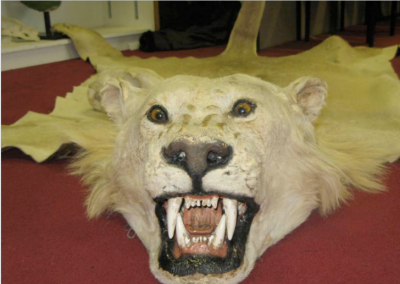|

Trading to extinction?
During the last few days, CITES delegates at the triennial Conference voted down proposed uplisting of all African elephants and lions to Appendix I – the highest level of protection from legal trade. Many nations, organizations, NGOs and individuals have spoken out in no uncertain terms about what they see as a betrayal and pandering to vested interests. After all, no less than 12 African nations backed a proposal to place all elephants on Appendix I, as opposed to a handful of southern African nations which opposed the uplisting. Similarly, support to uplist African lions to Appendix I was provided by a group of mostly western African nations but also opposed by the same southern African contingent. Of course, the possibility of uplisting lions and elephants was not assisted by the EU, WWF, TRAFFIC,IUCN, the Zoological Society of London and the CITES Secretariat itself, all of which recommended months before the Conference that such uplisting was not justified.
So should we be surprised by the outcome? Not really, as the writing was already on the wall long before the Conference. As one EU delegate reportedly said - “It is the nature of compromise that not everyone gets what they want.” In this case, perhaps as a compromise to balance negative views on uplisting, legal trade in elephant ivory, proposed by South Africa, Namibia and Zimbabwe was rejected, and for lions, there will be no trade in bones, teeth and claws from wild lions. Captive bred lions in South Africa can still be used to provide such products within limitations. Critics are right to say that wild lion products will easily be “washed” into the legal captive lion trade.
So should we be disappointed by the outcome? Yes, and especially so if we ascribe to the mistaken belief that CITES is some sort of conservation organization. It is not. The mandate for CITES is to regulate legal trade, nothing else. And CITES is not very good at that either. Tom Milliken of TRAFFIC said - “Where elephants fall on the CITES appendices is inconsequential to their survival. All the paper protection in the world is not going to compensate for poor law enforcement, rampant corruption and ineffective management.”
That is very true. Look for example at Tanzanias’ and Kenyas’ elephants, both of which are on Appendix I. Tanzania used to have about 136,000 elephants in 1997, and latest surveys show only 43,000 remaining in 2015. The Kenya Wildlife Service until very recently claimed a population in excess of 35,000 elephants, but surveys in 2015 showed only about 26,000 in the country. The missing elephants were all poached and their ivory trafficked to Asian destinations with the assistance of corrupt officials.
Among the big cats, tigers, leopards, snow leopards, cheetahs and clouded leopards are all on Appendix I but this has not prevented relentless declines caused by poaching and the illegal trade. An Appendix I listing, therefore, is rather meaningless in the face of an illegal wildlife trade increasingly responsible for the decimation of global wildlife.
The way forward does surely not rest with CITES. Instead, individual countries must take much greater responsibility to manage their wildlife carefully. In the absence of comprehensive policies and effective organizations, it was recently shown that Kenya has lost 68% of wildlife since 1977, and such losses are mirrored in many other African countries. Indeed, the persistence and viability of even relatively “common” Kenyan wildlife species like warthog, lesser kudu, Thomson’s gazelle, eland, oryx, topi, hartebeest, impala, Grevy’s zebra and waterbuck is now in doubt . Also, each sovereign nation is perfectly free to impose stricter guidelines than those suggested by CITES. If the 12 African nations wanted to have all elephants listed on Appendix I (which they already are in those countries – only South African, Zimbabwean, Namibian and Botswanan elephants are on Appendix II) then they must also individually do better to protect elephants within their borders. In fact, three (Kenya, Nigeria, Uganda) of the 12 countries that proposed uplisting of elephants are heavily implicated as source and transit countries for the illegal ivory trade and have been named as “countries of concern” by CITES. Responsible conservation should start at home.
The same can be said for the nine African nations proposing Appendix I listing for lions. Of the nine nations proposing the uplisting, lions are extinct or barely present in six countries and rapidly declining in the remaining three countries. The reason why lions are now critically endangered in western and central Africa is largely due to ineffectual national lion conservation management policies.
Any sovereign nation can close her borders to nationally unwanted wildlife trade no matter what CITES suggests. More effective than watered down and “compromise” CITES resolutions are the actions by Australia, France and the Netherlands that have banned imports of all lion products for example. We need far more countries to take such courses instead of merely expressing regret that the overall consensus at CITES went against their vote. And this is where we can all be much more effective – rather than dealing with 182 CITES “Parties”, we can lobby much more effectively to close down wildlife trade of individual countries. This course of action, in my opinion, is where the future lies for conservation of wildlife affected by the illegal and the contentious legal trade.
|




